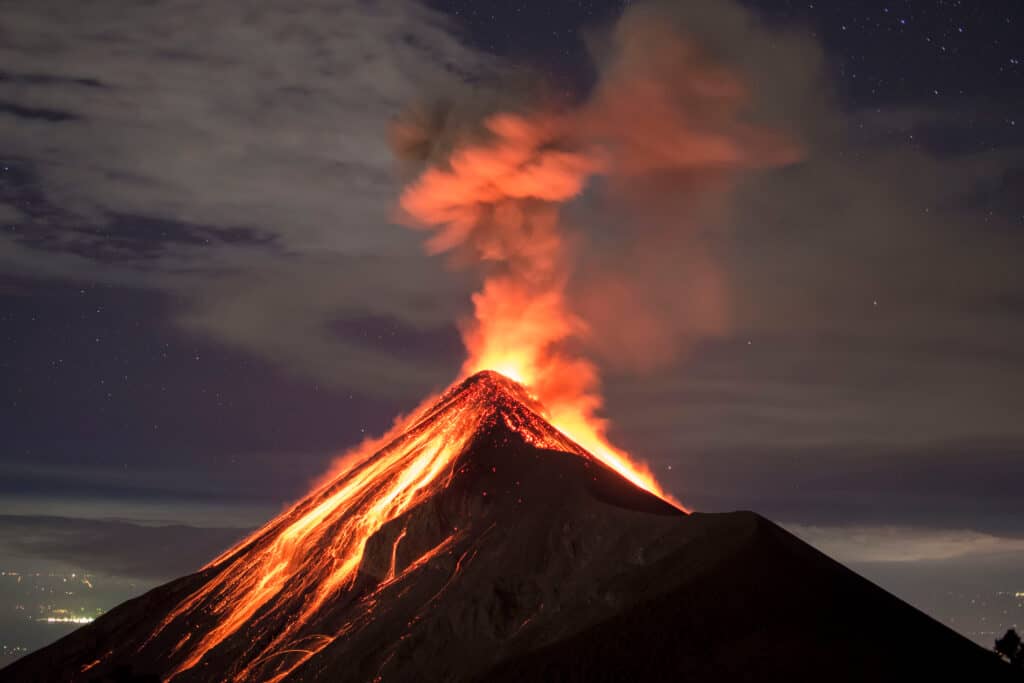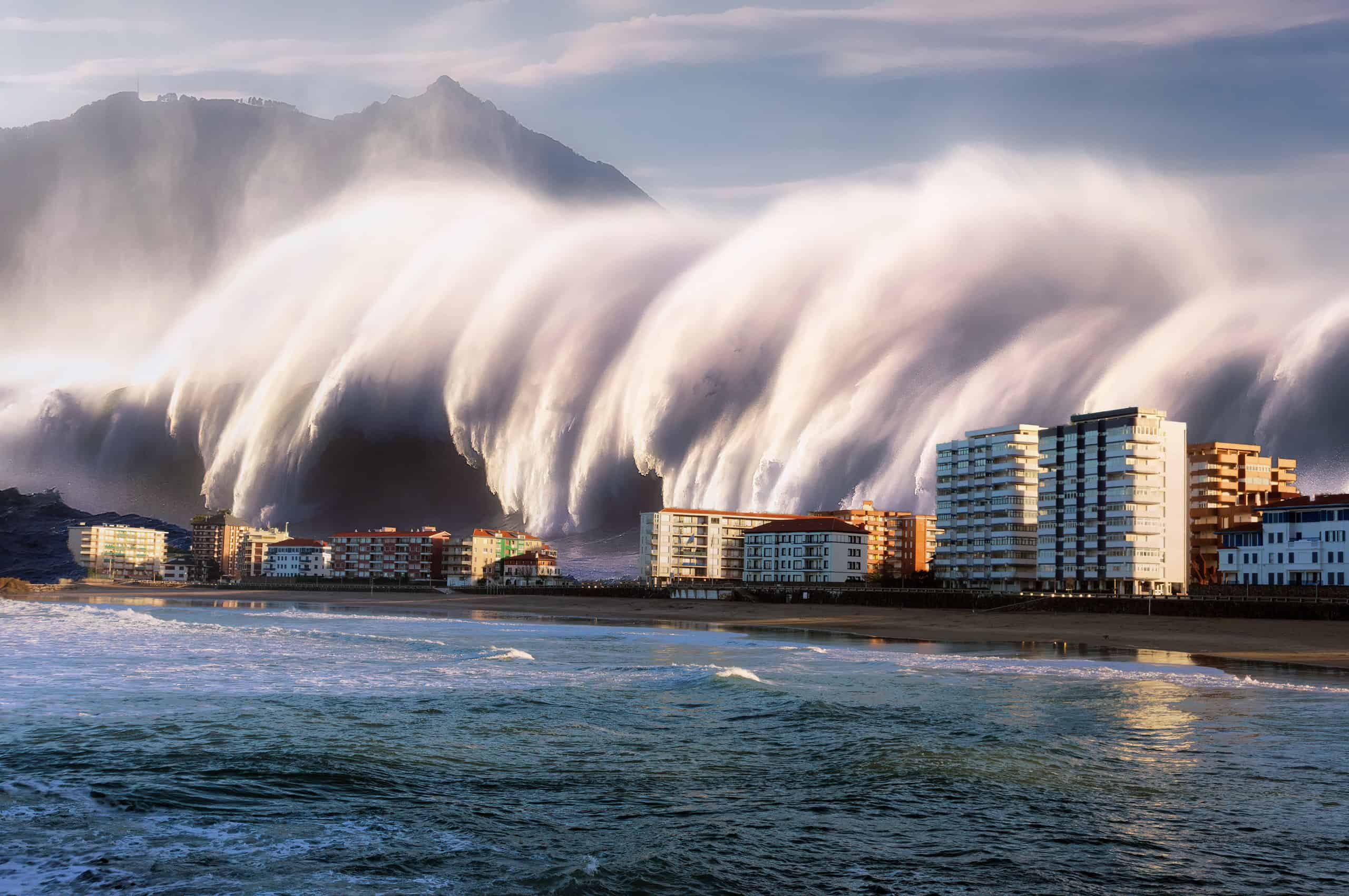You know about volcanoes and tsunamis, but volcanic tsunamis? What causes them? Are they so dangerous? Why do they even exist?
Volcanic tsunamis can be described as somewhat infrequent. Since the 19th and 20th centuries combined, we’ve only experienced 90–100 of them. The average year sees between 60 and 80 volcanic eruptions, making the number of eruptions per year approximately that high. Because of this, they represent a very minor share of all volcanic activity. However, they have a disproportionately large impact on fatalities. Since the middle of the 18th century, they have been responsible for 20–25% of all known deaths that are directly related to volcanoes. A single incident could claim the lives of tens of thousands of people.
Keep in mind that the risks associated with volcanic tsunamis aren’t restricted to select parts of the world. The Pacific and central Atlantic ocean coasts, among others, are at risk. About 15% of tsunamis are triggered by volcanoes or landslides.

There are approximately 60 to 80 volcanic eruptions each year.
©fboudrias/Shutterstock.com
What’s a Volcanic Tsunami – What Are Its Causes?
A volcanic tsunami is a large-scale water movement spurred on by a volcano whether erupting or not. There’s a wide range of volcanic processes that can cause tsunamis. However, the largest and most dangerous volcanic tsunamis are those caused by massive landslides.
Although uncommon, volcanic tsunamis can also be produced during eruptions by underwater explosions and shock waves triggered by huge explosions. This includes those that take place above the water. Tsunamis up to ten feet tall can be formed when shock waves and ocean waves combine. As a result, the sea can occasionally behave in exceedingly dangerous ways just from the intensity of the eruption.
Examples of shock wave-induced volcanic tsunamis include the August 1883 eruption of Krakatoa in Indonesia and the 2022 Hunga Tonga–Hunga Ha’apai eruption and tsunami. The latter spurred tsunamis that damaged coastlines in Tonga, Japan, Fiji, Vanuatu, Peru, New Zealand, American Samoa, the United States, Russia Far East, and Chile.
Regardless of the tectonic or volcanic origin of an earthquake, landslides and debris avalanches are possible side consequences. Water gets displaced and tsunamis happen, wherever these enormous movements of rock, ash, and other debris. This still occurs whether they do so above or below the ocean’s surface.
The majority of volcanoes in the world are steep and are composed primarily of piles of debris and loose material. They frequently contain hydrothermal systems that change and erode even the hardest lava and have destabilizing intrusions from fresh magma.
The steepest slopes are created by underwater lava flows as a result of coral reef buildup or quick cooling. When multiple of these conditions come together on a single volcano, an entire sector can collapse without an eruption or an earthquake.

While you may think volcanic tsunamis are only caused by eruptions, the most dangerous are actually caused by landslides.
©iStock.com/Josephine Jullian
Why Are Volcanic Tsunamis So Dangerous?
As with every disastrous event, volcanic tsunamis cause severe damage to the entire ecosystem. This includes human beings, animals, plants, and the environment.
Volcanic tsunamis pose a serious threat to human health, coastal infrastructure, property, and coastal resources. Not only that, but they also damage the local, regional, and even national economies.
Effects may endure for a very long time and extend well inland as well as along the shore. Volcanic tsunamis often cause the most severe damage and fatalities close to their source. This is because there is usually little time for warning,
The risk posed by the water is just as damaging as it carries people and debris back into the sea. Flooding, wave impacts, erosion, strong currents, and floating debris account for most of the tsunami’s wreckage.
There could also be the loss of wildlife habitats, alteration to beaches, and modifications to the quality and accessibility of freshwater. Long or short-term saltwater inundation can render agricultural land worthless.
Species in the marine ecosystem aren’t left out. Volcanic tsunamis can significantly disrupt some aquatic ecosystems in shallow water. This makes them less useful as nurseries and refuges for marine organisms—animals that live on, are attached to, or burrow in the sediment of the ocean floor. Unfortunately, these effects could have a long-lasting effect on the entire food chain.
Volcanic Tsunamis and Climate Change
Sea levels are rising, glaciers and ice caps are melting, and storms and cyclones are occurring more frequently and with greater intensity as the earth warms. Geological shifts related to climate can increase the frequency of earthquakes and volcanic eruptions. This alone can worsen the threat of tsunamis. Climate change does, in more ways than one, increase the threat of volcanic tsunamis.
Coastal populations are becoming more susceptible to tsunamis as well as storm-related flooding as sea levels rise. Because a tsunami can move farther inland, even slight sea level rises will significantly increase the frequency and intensity of flooding when one happens.
Since the ice age (glacial period) ended, 12,000 years ago, there’s been a sharp rise in volcanic activity sparked by the melting ice. In a process known as isostatic rebound or glacial isostatic readjustment, the Earth’s crust reacts to significant weight or pressure changes caused by a post-glacial rebound.
According to the National Oceanic and Atmospheric Administration, much of Canada, the Midwest, and the Northeast of the United States were covered in ice during the previous ice age. North America is still rising where the heavy glacial deposits of ice forced it under, despite the fact that the ice has long since receded. The United States’ East Coast and the Great Lakes region, which were previously on the protruding fore bulge of those old ice levels, are still gradually sinking as a result of fore bulge collapse.
Citing the Geological Society of America, they predicted that the fore bulge collapse will cause the Chesapeake Bay region’s land to sink by as much as half a foot during the next 100 years.
Apart from ice melting, there is a tsunami risk associated with the collapse of ice sheets. As they collide with unstable strata on the seafloor, icebergs can cause undersea landslides and tsunamis, thousands of miles from the iceberg’s initial source.
Tsunami waves caused by landslides or rock collapses don’t usually go as far as those caused by earthquakes, nonetheless, they can cause enormous waves.
In Alaska, unstable slopes have been made visible by glacial retreat and permafrost melting. In 2015, this melting resulted in a landslide that threw 180 million tons of rock into a fjord. This, in turn, caused a tsunami to rise 633 feet. One of the largest ever recorded globally.
A dangerous tsunami could occur in the Barry Arm in Alaska and northwest British Columbia within the next 20 years. This is due to an unstable mountain slope at the foot of the Barry Glacier.
Up Next…
Take a look at some of our other articles about just how scary our planet can be!
- Tsunami – Find out just what causes them and how they are formed in detail.
- 12 Most Devastating Earthquakes – Read on to find out about the worst earthquakes in history.
- 9 Most Devastating Landslides – See our list of the worst landslides to ever happen in the U.S.
Thank you for reading! Have some feedback for us? Contact the AZ Animals editorial team.








